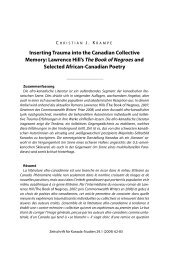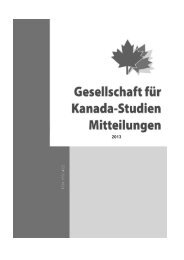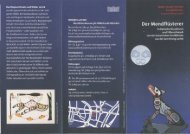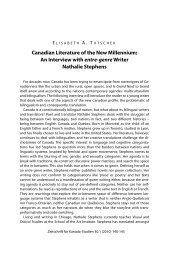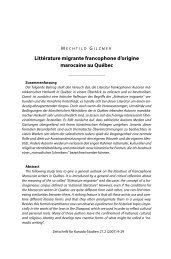The Beginnings of Contemporary Aboriginal Literature in Canada ...
The Beginnings of Contemporary Aboriginal Literature in Canada ...
The Beginnings of Contemporary Aboriginal Literature in Canada ...
Create successful ePaper yourself
Turn your PDF publications into a flip-book with our unique Google optimized e-Paper software.
68 Hartmut Lutz<br />
function to non-Native readers. It was not until twenty years later that Saulteaux<br />
storyteller Alexander Wolfe achieved a similar degree <strong>of</strong> literary self-determ<strong>in</strong>ation<br />
with his collection Earth Elder Stories. In 1967, with his conscious effort to preserve<br />
his heritage for future generations, and to share it with a general public by publish<strong>in</strong>g<br />
and expla<strong>in</strong><strong>in</strong>g it, Clutesi was ahead <strong>of</strong> his time. 3<br />
After this achievement, most collections <strong>of</strong> tales from Oral Traditions edited, illustrated<br />
and published by <strong>Aborig<strong>in</strong>al</strong> authors and artists <strong>in</strong> the early 1970s had a<br />
clearly didactic function and were addressed to children. Some were put together<br />
to preserve what seemed threatened, <strong>in</strong> order to make available to young First Nations<br />
children the lessons <strong>of</strong> their elders, while others were published to teach the<br />
young <strong>in</strong> general, regardless <strong>of</strong> their ethnic background. In her short <strong>in</strong>troduction to<br />
Tales <strong>of</strong> Nokomis, Anishnabe author Patronella Johnston relates that these stories<br />
were told to her <strong>in</strong> the w<strong>in</strong>ter months by an old lady for whom she did chores, but<br />
that when she told the same stories to her own foster children she realized “how<br />
little they knew <strong>of</strong> their own folk heritage. […] So I began to put them down on<br />
paper. Otherwise they would have been gone forever” (Johnston 1970, ix). Her fellow<br />
Anishnabe artist, Daphne “Odjig” Beavon, retold and illustrated Nanabush and<br />
the Geese <strong>in</strong> the style <strong>of</strong> a Woodland Art comic book for school children, hop<strong>in</strong>g<br />
“that besides be<strong>in</strong>g <strong>of</strong> enterta<strong>in</strong>ment value, the moral truths that were so important<br />
to Indians will cont<strong>in</strong>ue <strong>in</strong> years to come” (Johnston 1971, ix). Her book came complete<br />
with (moraliz<strong>in</strong>g) didactic questions entitled: “Th<strong>in</strong>k and Talk”, by Basil Johnston,<br />
the scholar who later became the most famous Anishnabe scholarly writer, and<br />
who was then work<strong>in</strong>g for the Royal Ontario Museum <strong>in</strong> Toronto.<br />
Out <strong>of</strong> British Columbia came at least two books that were based on collective efforts<br />
<strong>in</strong>volv<strong>in</strong>g community elders and school children: In 1971 ‘Ksan Book Builders<br />
published We-Gyet Wanders On, and two years later Indian Children <strong>of</strong> British Columbia<br />
brought out Tales from the Longhouse. <strong>The</strong> first is an illustrated bil<strong>in</strong>gual<br />
collection <strong>of</strong> Weegit stories, told <strong>in</strong> Gitskan and English, and <strong>in</strong>clud<strong>in</strong>g ‘Ksan ethno-<br />
3 Twenty years after its publication <strong>in</strong> <strong>Canada</strong>, Son <strong>of</strong> Raven, Son <strong>of</strong> Deer was published <strong>in</strong> West<br />
Germany <strong>in</strong> the Catholic “mission”-publish<strong>in</strong>g house <strong>in</strong> a translation by Herta Holle-Scherer,<br />
then a pr<strong>of</strong>essor at the German Department <strong>of</strong> the University <strong>of</strong> Reg<strong>in</strong>a. <strong>The</strong> title, Sohn des Raben,<br />
Sohn des Rehs, under the rubric “<strong>in</strong>dianische Fabeln” is somewhat mislead<strong>in</strong>g, s<strong>in</strong>ce there is<br />
no “Reh” (pronounced like “ray” with a glottal “r”) <strong>in</strong> North America. “Rehe” belong to the deer<br />
family, but they are a very small species, and are clearly dist<strong>in</strong>ct from the four other species <strong>of</strong><br />
“Hirsche” or deer, found <strong>in</strong> Europe, and rang<strong>in</strong>g from “Damhirsch” (fallow deer), “Sika-Hirsch”<br />
(sika deer, an import from Japan), “Rothirsch” (red deer, a smaller cous<strong>in</strong> <strong>of</strong> the American elk or<br />
wapiti) and “Elche” (American “moose” or English “elk”). <strong>The</strong> correct title would have been, therefore,<br />
“Sohn des Raben, Sohn des Hirschs”. Translations <strong>of</strong> terms regard<strong>in</strong>g flora and fauna are<br />
tricky. So is classify<strong>in</strong>g Clutesi’s book under “Fabeln.” It evokes the tradition <strong>of</strong> moraliz<strong>in</strong>g animal<br />
tales used <strong>in</strong> European education and rang<strong>in</strong>g from Aesop to Lafonta<strong>in</strong>e and many later adaptations,<br />
thus <strong>in</strong>corporat<strong>in</strong>g, as it were, Clutesi’s orature <strong>in</strong>to a European tradition. See: George<br />
Clutesi, Sohn des Raben, Sohn des Rehs, aus dem Englischen übersetzt von Herta Holle-Scherer.



